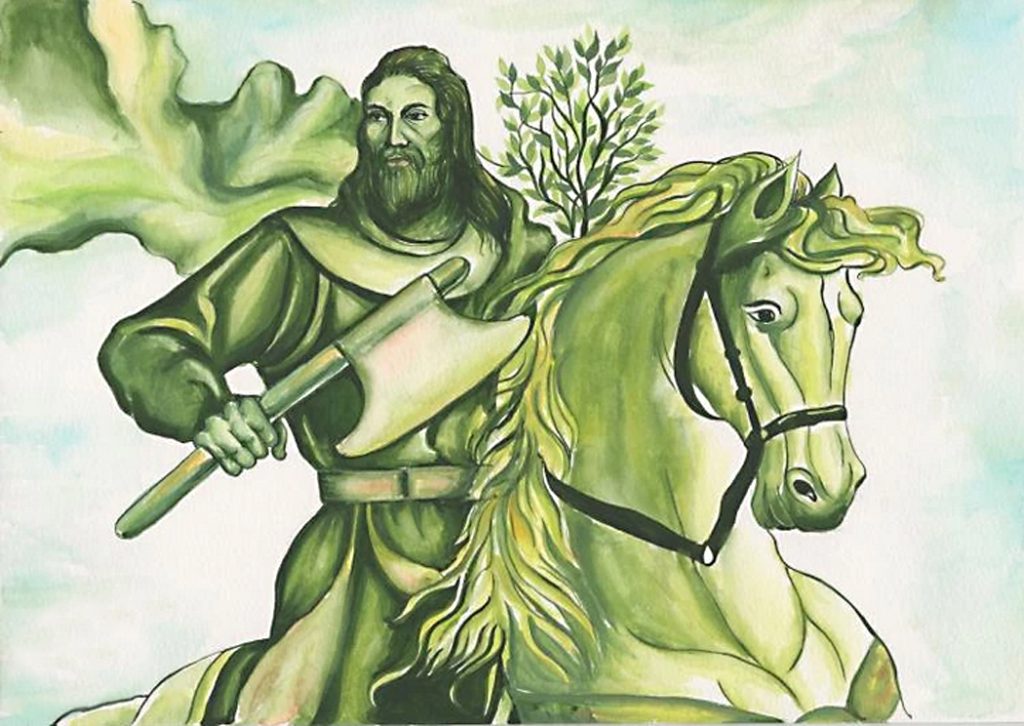
Of all our instincts, self-preservation stands as one of the most fundamental. Deeply ingrained in our evolutionary heritage, the drive to survive has led us to continuously pursue comfort, security, and stability. We’ve been successful in these aims, so much so that we live in a time increasingly characterized by convenience and access to material comforts. However, this very success has given rise to unintended consequences. Our relentless pursuit of material goods has not only fostered an economy that encourages a “get mine and get out” mentality, but also leads us to overlook crucial opportunities for connection to the natural world.
Is it possible that our need for self-preservation has gone too far? What are we missing when we disconnect ourselves from the wilderness and her many challenges? This month, we continue our dive into how we relate to the natural world.
The Green Knight
In the 14th-century poem Sir Gawain and the Green Knight, a Christmas celebration within King Arthur’s court is suddenly interrupted by the arrival of a gigantic green-hued knight and horse. The mysterious visitor insists his intentions are friendly and proposes a wager over his axe: anyone may give him a single strike, provided that the Green Knight may return the blow on a later date. One knight, Sir Gawain, accepts the challenge, and beheads the giant in one stroke. And yet, the Green Knight promptly reaches for his head, picks it back up, and instructs Gawain to meet him in one year and a day at a “Green Chapel” for his turn.
The poem follows Gawain’s internal conflict between his drive for survival and his moral obligation to the Green Knight and King Arthur’s kingdom. Gawain ultimately honors his promise by finding the chapel, but, with a degree of dishonesty, conceals a supposedly magical garment in hopes of saving himself. The Green Knight, recognizing Gawain’s bravery, spares his life, but delivers a scratch on Gawain’s neck for his deception.
In this story, the Green Knight is commonly thought of as a symbol of untamed nature, an unpredictable chaotic force that challenges Gawain and the society he represents. However, the Green Knight also assumes the role of a teacher, requiring Gawain to relinquish control, put himself at the mercy of something greater than himself, and relax his need for self-preservation. In other words—nature teaches Gawain to be free.
Herein lies a paradox: all of us, like Sir Gawain, are simultaneously afraid of wilderness and in deep need of wilderness. Our evolutionary history has made this so. As a matter of survival, our minds and bodies were optimized to both connect with nature and to never fully trust it. As with most paradoxes, the way forward is complicated and by no means black and white. If we lean too far into comfort and convenience, our lives can become more hollow and disconnected. But if we walk too far on the “wild side,” we can create unhealthy suffering, risk, and unpredictability.
However, with the right balance, we stand to gain the benefits of freedom, humility, selflessness, and an inherently meaningful and connected life.
In a paper titled “The Rewilding of the Human Species,”1 eco-psychologists Dr. Peter Kahn and Dr. Patricia Hasbach propose that integrating the wild with our advancing technological landscape is essential for our species to flourish. Towards this aim, they argue the importance of 1) healthily embracing one’s “primal self” in relation to nature and other humans, 2) recognizing and appreciating our fear of nature, instead of running from it, 3) welcoming fluctuations in the satisfaction of our needs and desires, and 4) flattening social hierarchies for equitable and healthy rewilding. Whether we live in the woods, or in the midst of busy urban life, their work provides insights that can be appreciated and utilized.
Venturing to the Green Chapel
In contemplating the lessons from Sir Gawain and the Green Knight, we find that our modern dilemmas echo the age-old conflict between our need for self-preservation and our primal longing for the untamed, the chaotic, and the awe-inspiring. Just as Gawain ventured to the Green Chapel, we too must embark on our journey toward a more connected existence, where the wilderness is not forgotten but an essential part of our lives. A degree of humility is an inevitable part of this process too. After all, even Sir Gawain clung to a garment to save himself from oblivion.
- Kahn, P. H., Jr., & Hasbach, P. H. (2013). The rewilding of the human species. In P. H. Kahn, Jr. & P. H. Hasbach (Eds.), The rediscovery of the wild (pp. 207-232). Cambridge, MA: MIT Press.
For more information, please email MappingTheGreen@gmail.com.
